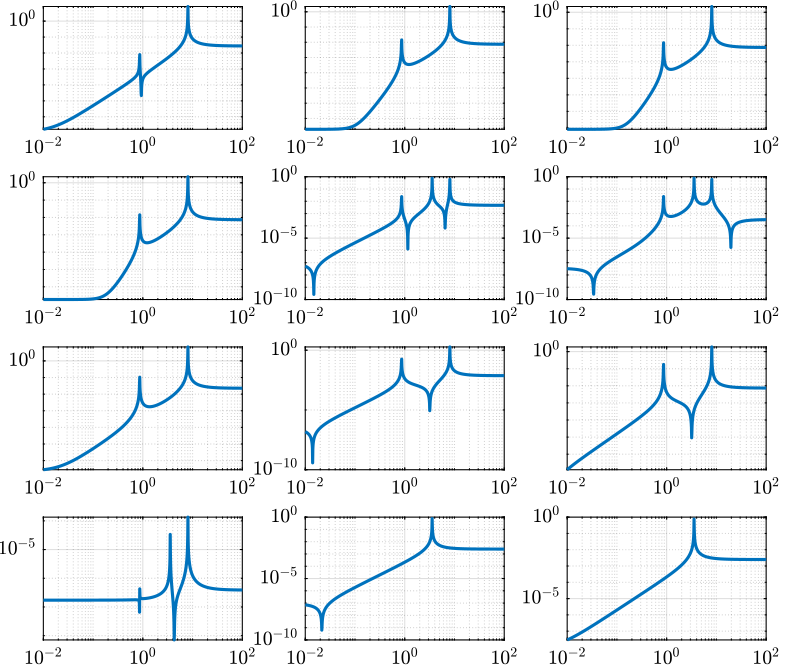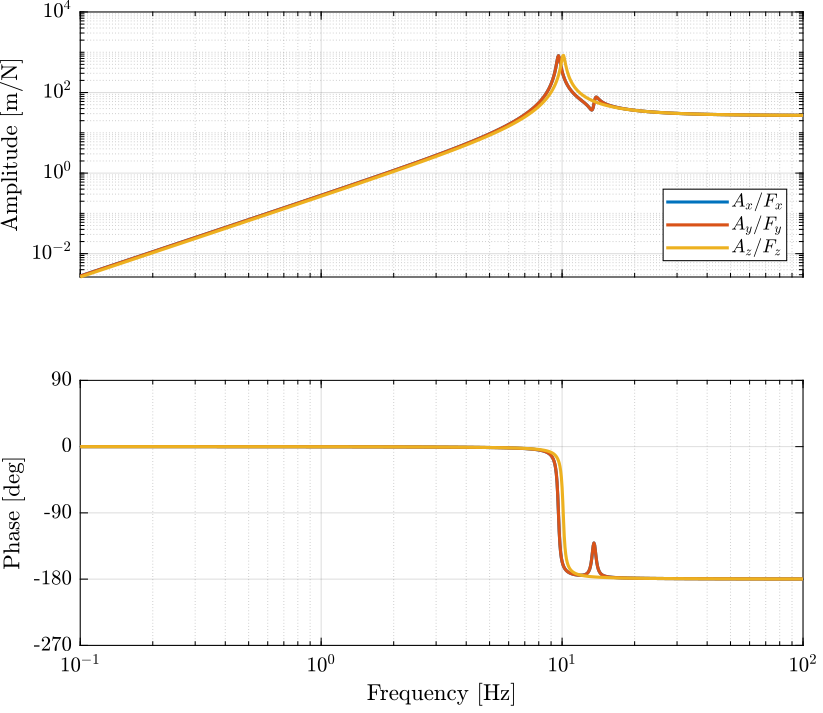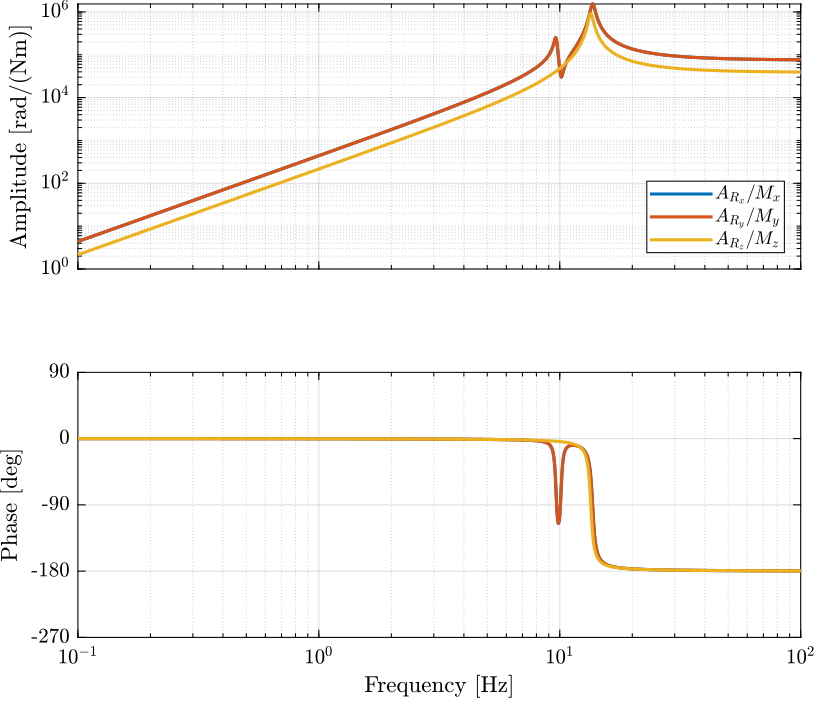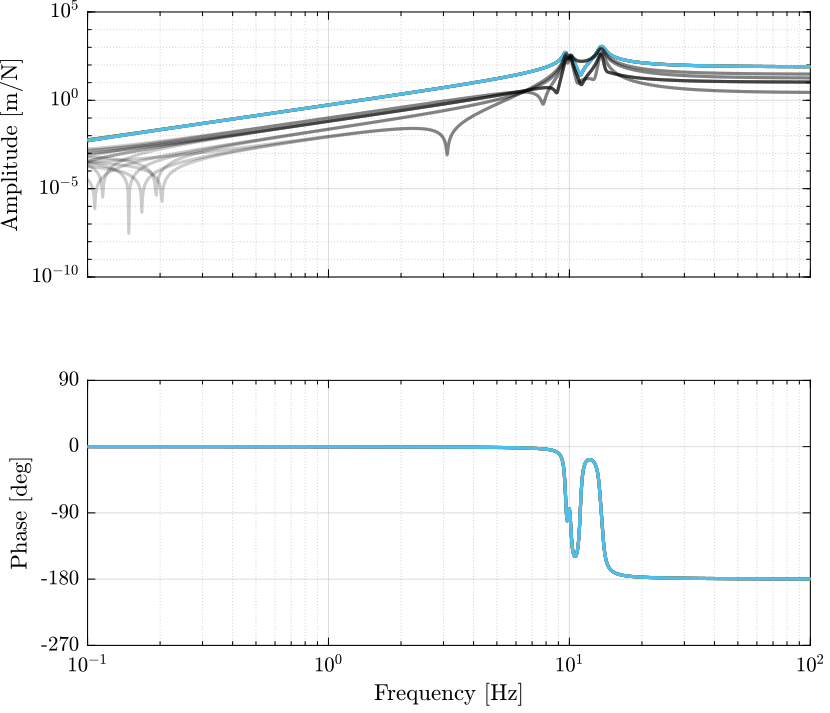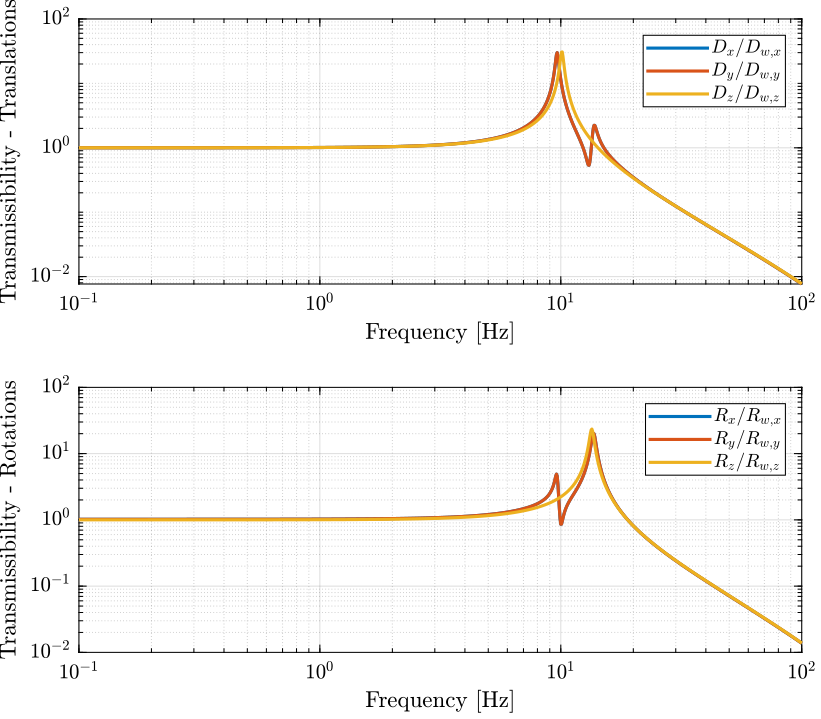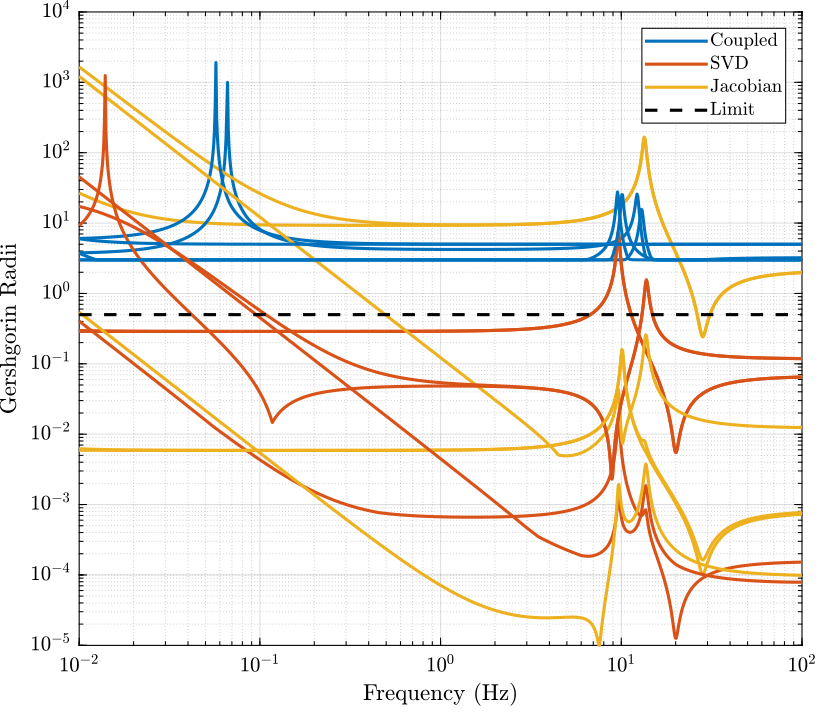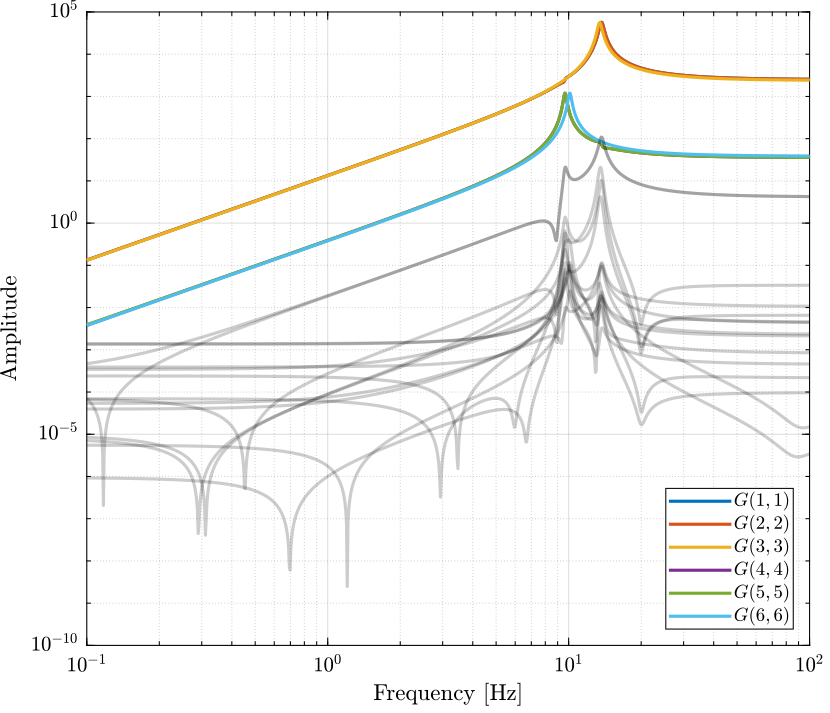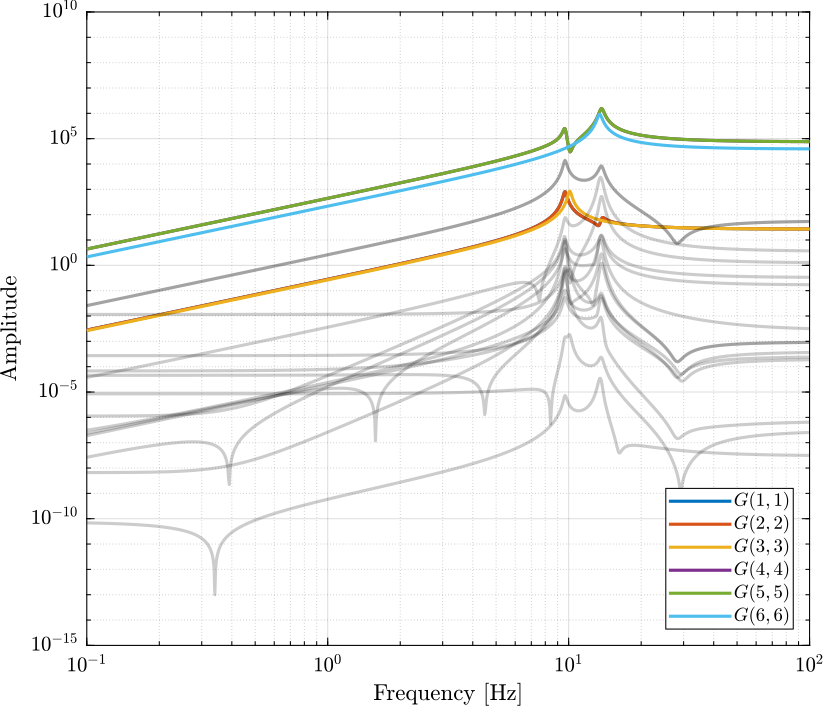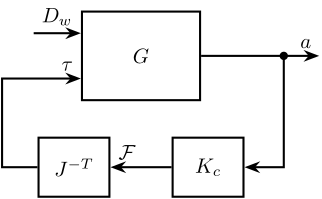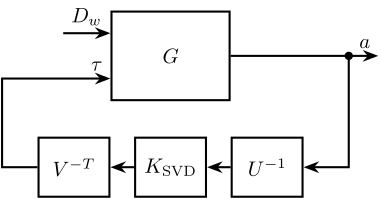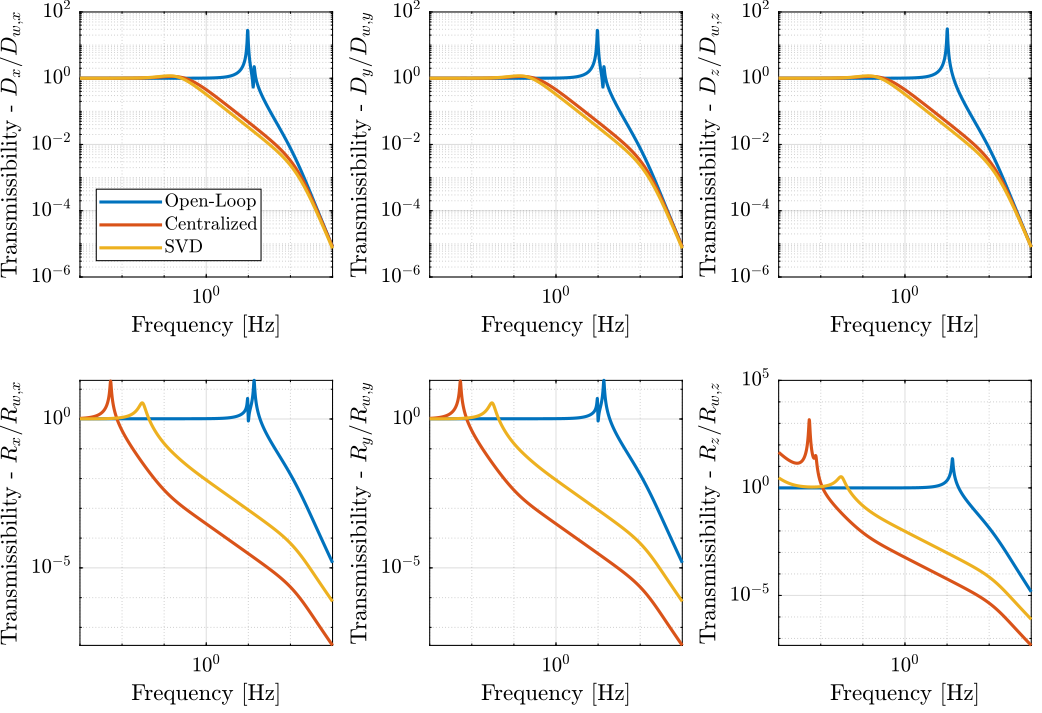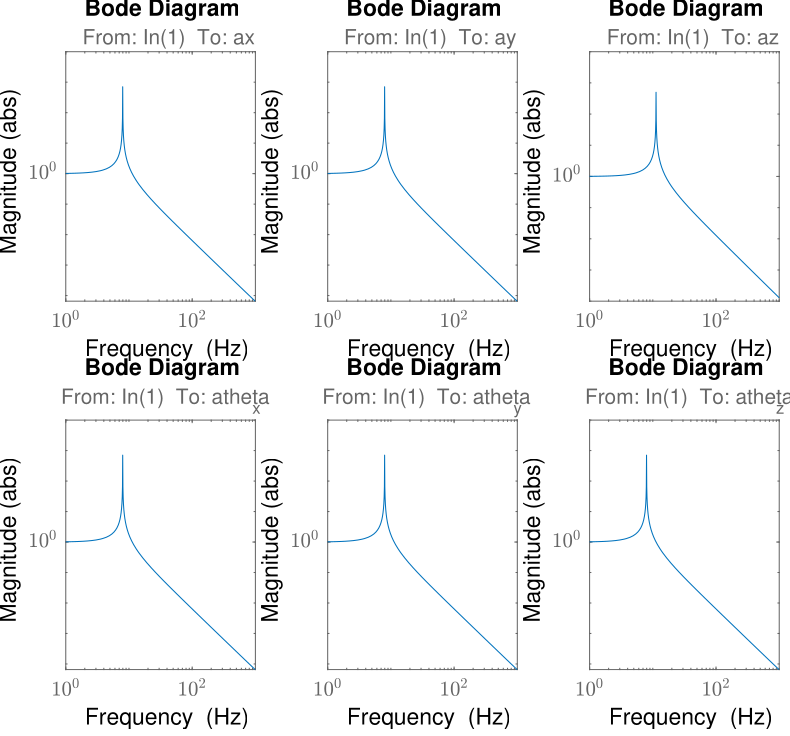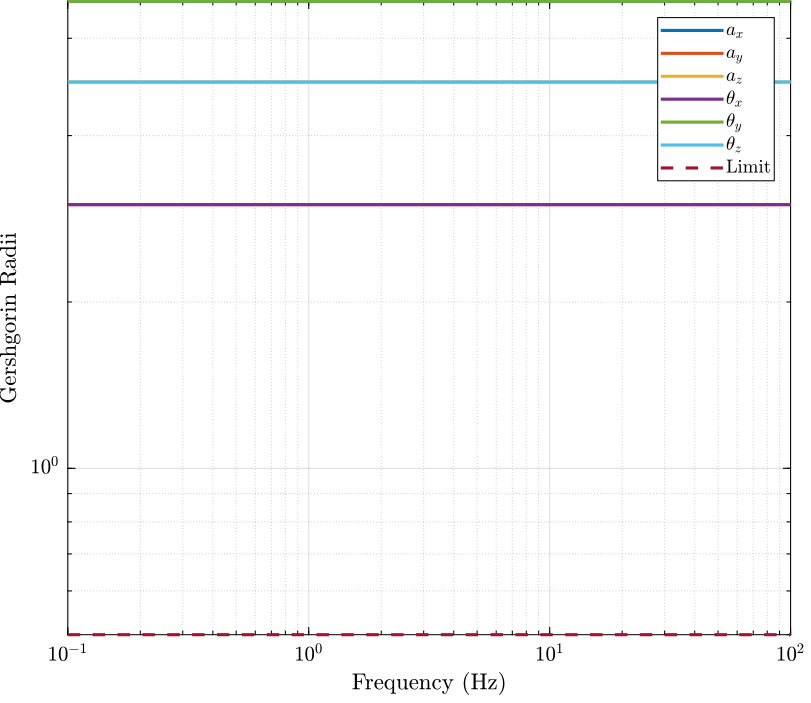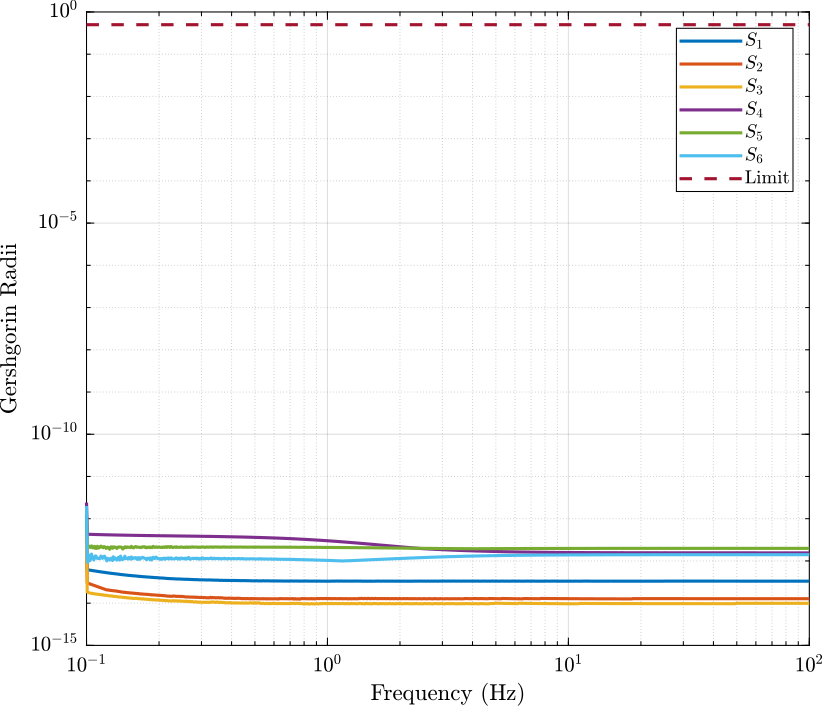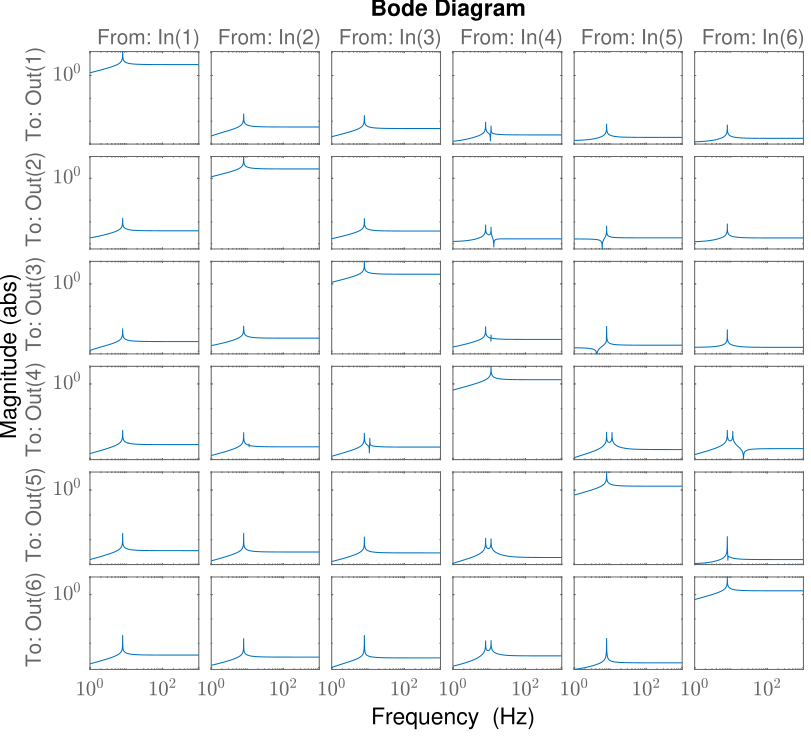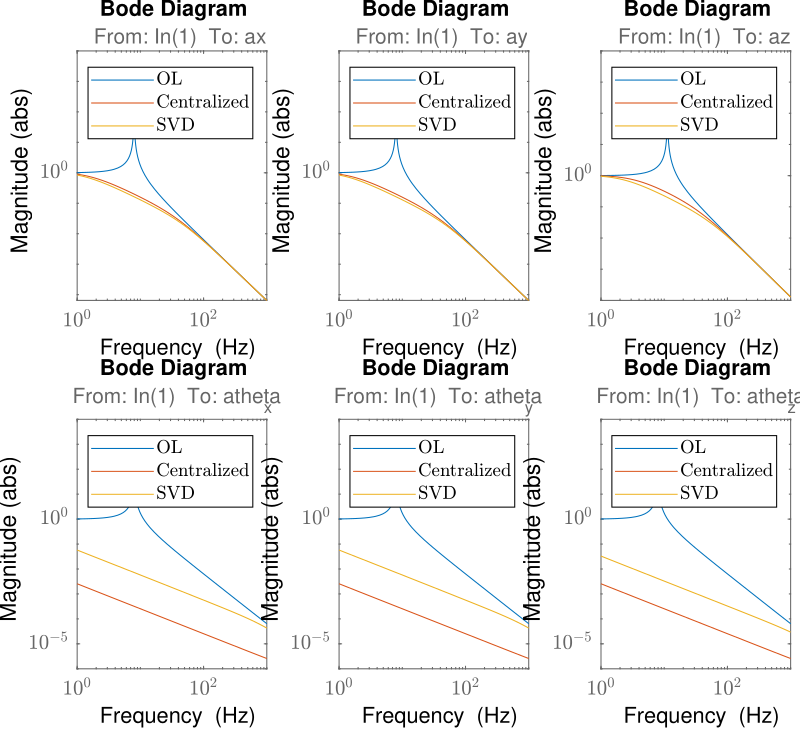38 KiB
SVD Control
Gravimeter - Simscape Model
Simulink
open('gravimeter.slx') %% Name of the Simulink File
mdl = 'gravimeter';
%% Input/Output definition
clear io; io_i = 1;
io(io_i) = linio([mdl, '/F1'], 1, 'openinput'); io_i = io_i + 1;
io(io_i) = linio([mdl, '/F2'], 1, 'openinput'); io_i = io_i + 1;
io(io_i) = linio([mdl, '/F3'], 1, 'openinput'); io_i = io_i + 1;
io(io_i) = linio([mdl, '/Acc_side'], 1, 'openoutput'); io_i = io_i + 1;
io(io_i) = linio([mdl, '/Acc_side'], 2, 'openoutput'); io_i = io_i + 1;
io(io_i) = linio([mdl, '/Acc_top'], 1, 'openoutput'); io_i = io_i + 1;
io(io_i) = linio([mdl, '/Acc_top'], 2, 'openoutput'); io_i = io_i + 1;
G = linearize(mdl, io);
G.InputName = {'F1', 'F2', 'F3'};
G.OutputName = {'Ax1', 'Az1', 'Ax2', 'Az2'};The plant as 6 states as expected (2 translations + 1 rotation)
size(G)State-space model with 4 outputs, 3 inputs, and 6 states.
Stewart Platform - Simscape Model
Jacobian
First, the position of the "joints" (points of force application) are estimated and the Jacobian computed.
open('stewart_platform/drone_platform_jacobian.slx'); sim('drone_platform_jacobian'); Aa = [a1.Data(1,:);
a2.Data(1,:);
a3.Data(1,:);
a4.Data(1,:);
a5.Data(1,:);
a6.Data(1,:)]';
Ab = [b1.Data(1,:);
b2.Data(1,:);
b3.Data(1,:);
b4.Data(1,:);
b5.Data(1,:);
b6.Data(1,:)]';
As = (Ab - Aa)./vecnorm(Ab - Aa);
l = vecnorm(Ab - Aa)';
J = [As' , cross(Ab, As)'];
save('./jacobian.mat', 'Aa', 'Ab', 'As', 'l', 'J');Simscape Model
open('stewart_platform/drone_platform.slx');Definition of spring parameters
kx = 50; % [N/m]
ky = 50;
kz = 50;
cx = 0.025; % [Nm/rad]
cy = 0.025;
cz = 0.025;We load the Jacobian.
load('./jacobian.mat', 'Aa', 'Ab', 'As', 'l', 'J');Identification of the plant
The dynamics is identified from forces applied by each legs to the measured acceleration of the top platform.
%% Name of the Simulink File
mdl = 'drone_platform';
%% Input/Output definition
clear io; io_i = 1;
io(io_i) = linio([mdl, '/Dw'], 1, 'openinput'); io_i = io_i + 1;
io(io_i) = linio([mdl, '/u'], 1, 'openinput'); io_i = io_i + 1;
io(io_i) = linio([mdl, '/Inertial Sensor'], 1, 'openoutput'); io_i = io_i + 1;
G = linearize(mdl, io);
G.InputName = {'Dwx', 'Dwy', 'Dwz', 'Rwx', 'Rwy', 'Rwz', ...
'F1', 'F2', 'F3', 'F4', 'F5', 'F6'};
G.OutputName = {'Ax', 'Ay', 'Az', 'Arx', 'Ary', 'Arz'};There are 24 states (6dof for the bottom platform + 6dof for the top platform).
size(G)State-space model with 6 outputs, 12 inputs, and 24 states.
% G = G*blkdiag(inv(J), eye(6));
% G.InputName = {'Dw1', 'Dw2', 'Dw3', 'Dw4', 'Dw5', 'Dw6', ...
% 'F1', 'F2', 'F3', 'F4', 'F5', 'F6'};Thanks to the Jacobian, we compute the transfer functions in the frame of the legs and in an inertial frame.
Gx = G*blkdiag(eye(6), inv(J'));
Gx.InputName = {'Dwx', 'Dwy', 'Dwz', 'Rwx', 'Rwy', 'Rwz', ...
'Fx', 'Fy', 'Fz', 'Mx', 'My', 'Mz'};
Gl = J*G;
Gl.OutputName = {'A1', 'A2', 'A3', 'A4', 'A5', 'A6'};Obtained Dynamics
Real Approximation of $G$ at the decoupling frequency
Let's compute a real approximation of the complex matrix $H_1$ which corresponds to the the transfer function $G_c(j\omega_c)$ from forces applied by the actuators to the measured acceleration of the top platform evaluated at the frequency $\omega_c$.
wc = 2*pi*20; % Decoupling frequency [rad/s]
Gc = G({'Ax', 'Ay', 'Az', 'Arx', 'Ary', 'Arz'}, ...
{'F1', 'F2', 'F3', 'F4', 'F5', 'F6'}); % Transfer function to find a real approximation
H1 = evalfr(Gc, j*wc);The real approximation is computed as follows:
D = pinv(real(H1'*H1));
H1 = inv(D*real(H1'*diag(exp(j*angle(diag(H1*D*H1.'))/2))));Verification of the decoupling using the "Gershgorin Radii"
First, the Singular Value Decomposition of $H_1$ is performed: \[ H_1 = U \Sigma V^H \]
[U,S,V] = svd(H1);Then, the "Gershgorin Radii" is computed for the plant $G_c(s)$ and the "SVD Decoupled Plant" $G_d(s)$: \[ G_d(s) = U^T G_c(s) V \]
This is computed over the following frequencies.
freqs = logspace(-2, 2, 1000); % [Hz]Gershgorin Radii for the coupled plant:
Gr_coupled = zeros(length(freqs), size(Gc,2));
H = abs(squeeze(freqresp(Gc, freqs, 'Hz')));
for out_i = 1:size(Gc,2)
Gr_coupled(:, out_i) = squeeze((sum(H(out_i,:,:)) - H(out_i,out_i,:))./H(out_i, out_i, :));
endGershgorin Radii for the decoupled plant using SVD:
Gd = U'*Gc*V;
Gr_decoupled = zeros(length(freqs), size(Gd,2));
H = abs(squeeze(freqresp(Gd, freqs, 'Hz')));
for out_i = 1:size(Gd,2)
Gr_decoupled(:, out_i) = squeeze((sum(H(out_i,:,:)) - H(out_i,out_i,:))./H(out_i, out_i, :));
endGershgorin Radii for the decoupled plant using the Jacobian:
Gj = Gc*inv(J');
Gr_jacobian = zeros(length(freqs), size(Gj,2));
H = abs(squeeze(freqresp(Gj, freqs, 'Hz')));
for out_i = 1:size(Gj,2)
Gr_jacobian(:, out_i) = squeeze((sum(H(out_i,:,:)) - H(out_i,out_i,:))./H(out_i, out_i, :));
endDecoupled Plant
Diagonal Controller
The controller $K$ is a diagonal controller consisting a low pass filters with a crossover frequency $\omega_c$ and a DC gain $C_g$.
wc = 2*pi*0.1; % Crossover Frequency [rad/s]
C_g = 50; % DC Gain
K = eye(6)*C_g/(s+wc);Centralized Control
The control diagram for the centralized control is shown below.
The controller $K_c$ is "working" in an cartesian frame. The Jacobian is used to convert forces in the cartesian frame to forces applied by the actuators.
\begin{tikzpicture}
\node[block={2cm}{1.5cm}] (G) {$G$};
\node[block, below right=0.6 and -0.5 of G] (K) {$K_c$};
\node[block, below left= 0.6 and -0.5 of G] (J) {$J^{-T}$};
% Inputs of the controllers
\coordinate[] (inputd) at ($(G.south west)!0.75!(G.north west)$);
\coordinate[] (inputu) at ($(G.south west)!0.25!(G.north west)$);
% Connections and labels
\draw[<-] (inputd) -- ++(-0.8, 0) node[above right]{$D_w$};
\draw[->] (G.east) -- ++(2.0, 0) node[above left]{$a$};
\draw[->] ($(G.east)+(1.4, 0)$)node[branch]{} |- (K.east);
\draw[->] (K.west) -- (J.east) node[above right]{$\mathcal{F}$};
\draw[->] (J.west) -- ++(-0.6, 0) |- (inputu) node[above left]{$\tau$};
\end{tikzpicture} G_cen = feedback(G, inv(J')*K, [7:12], [1:6]);SVD Control
The SVD control architecture is shown below. The matrices $U$ and $V$ are used to decoupled the plant $G$.
\begin{tikzpicture}
\node[block={2cm}{1.5cm}] (G) {$G$};
\node[block, below right=0.6 and 0 of G] (U) {$U^{-1}$};
\node[block, below=0.6 of G] (K) {$K_{\text{SVD}}$};
\node[block, below left= 0.6 and 0 of G] (V) {$V^{-T}$};
% Inputs of the controllers
\coordinate[] (inputd) at ($(G.south west)!0.75!(G.north west)$);
\coordinate[] (inputu) at ($(G.south west)!0.25!(G.north west)$);
% Connections and labels
\draw[<-] (inputd) -- ++(-0.8, 0) node[above right]{$D_w$};
\draw[->] (G.east) -- ++(2.5, 0) node[above left]{$a$};
\draw[->] ($(G.east)+(2.0, 0)$) node[branch]{} |- (U.east);
\draw[->] (U.west) -- (K.east);
\draw[->] (K.west) -- (V.east);
\draw[->] (V.west) -- ++(-0.6, 0) |- (inputu) node[above left]{$\tau$};
\end{tikzpicture}SVD Control
G_svd = feedback(G, pinv(V')*K*pinv(U), [7:12], [1:6]);Results
Let's first verify the stability of the closed-loop systems:
isstable(G_cen)ans = logical 1
isstable(G_svd)ans = logical 1
The obtained transmissibility in Open-loop, for the centralized control as well as for the SVD control are shown in Figure fig:stewart_platform_simscape_cl_transmissibility.
Stewart Platform - Analytical Model
Characteristics
L = 0.055;
Zc = 0;
m = 0.2;
k = 1e3;
c = 2*0.1*sqrt(k*m);
Rx = 0.04;
Rz = 0.04;
Ix = m*Rx^2;
Iy = m*Rx^2;
Iz = m*Rz^2;Mass Matrix
M = m*[1 0 0 0 Zc 0;
0 1 0 -Zc 0 0;
0 0 1 0 0 0;
0 -Zc 0 Rx^2+Zc^2 0 0;
Zc 0 0 0 Rx^2+Zc^2 0;
0 0 0 0 0 Rz^2];Jacobian Matrix
Bj=1/sqrt(6)*[ 1 1 -2 1 1 -2;
sqrt(3) -sqrt(3) 0 sqrt(3) -sqrt(3) 0;
sqrt(2) sqrt(2) sqrt(2) sqrt(2) sqrt(2) sqrt(2);
0 0 L L -L -L;
-L*2/sqrt(3) -L*2/sqrt(3) L/sqrt(3) L/sqrt(3) L/sqrt(3) L/sqrt(3);
L*sqrt(2) -L*sqrt(2) L*sqrt(2) -L*sqrt(2) L*sqrt(2) -L*sqrt(2)];Stifnness matrix and Damping matrix
kv = k/3; % [N/m]
kh = 0.5*k/3; % [N/m]
K = diag([3*kh,3*kh,3*kv,3*kv*Rx^2/2,3*kv*Rx^2/2,3*kh*Rx^2]); % Stiffness Matrix
C = c*K/100000; % Damping MatrixState Space System
A = [zeros(6) eye(6); -M\K -M\C];
Bw = [zeros(6); -eye(6)];
Bu = [zeros(6); M\Bj];
Co = [-M\K -M\C];
D = [zeros(6) M\Bj];
ST = ss(A,[Bw Bu],Co,D);- OUT 1-6: 6 dof
- IN 1-6 : ground displacement in the directions of the legs
- IN 7-12: forces in the actuators.
ST.StateName = {'x';'y';'z';'theta_x';'theta_y';'theta_z';...
'dx';'dy';'dz';'dtheta_x';'dtheta_y';'dtheta_z'};
ST.InputName = {'w1';'w2';'w3';'w4';'w5';'w6';...
'u1';'u2';'u3';'u4';'u5';'u6'};
ST.OutputName = {'ax';'ay';'az';'atheta_x';'atheta_y';'atheta_z'};Transmissibility
Real approximation of $G(j\omega)$ at decoupling frequency
sys1 = ST*[zeros(6); eye(6)]; % take only the forces inputs
dec_fr = 20;
H1 = evalfr(sys1,j*2*pi*dec_fr);
H2 = H1;
D = pinv(real(H2'*H2));
H1 = inv(D*real(H2'*diag(exp(j*angle(diag(H2*D*H2.'))/2)))) ;
[U,S,V] = svd(H1);
wf = logspace(-1,2,1000);
for i = 1:length(wf)
H = abs(evalfr(sys1,j*2*pi*wf(i)));
H_dec = abs(evalfr(U'*sys1*V,j*2*pi*wf(i)));
for j = 1:size(H,2)
g_r1(i,j) = (sum(H(j,:))-H(j,j))/H(j,j);
g_r2(i,j) = (sum(H_dec(j,:))-H_dec(j,j))/H_dec(j,j);
% keyboard
end
g_lim(i) = 0.5;
endCoupled and Decoupled Plant "Gershgorin Radii"
figure;
title('Coupled plant')
loglog(wf,g_r1(:,1),wf,g_r1(:,2),wf,g_r1(:,3),wf,g_r1(:,4),wf,g_r1(:,5),wf,g_r1(:,6),wf,g_lim,'--');
legend('$a_x$','$a_y$','$a_z$','$\theta_x$','$\theta_y$','$\theta_z$','Limit');
xlabel('Frequency (Hz)'); ylabel('Gershgorin Radii') figure;
title('Decoupled plant (10 Hz)')
loglog(wf,g_r2(:,1),wf,g_r2(:,2),wf,g_r2(:,3),wf,g_r2(:,4),wf,g_r2(:,5),wf,g_r2(:,6),wf,g_lim,'--');
legend('$S_1$','$S_2$','$S_3$','$S_4$','$S_5$','$S_6$','Limit');
xlabel('Frequency (Hz)'); ylabel('Gershgorin Radii')Controller
fc = 2*pi*0.1; % Crossover Frequency [rad/s]
c_gain = 50; %
cont = eye(6)*c_gain/(s+fc);Closed Loop System
FEEDIN = [7:12]; % Input of controller
FEEDOUT = [1:6]; % Output of controllerCentralized Control
STcen = feedback(ST, inv(Bj)*cont, FEEDIN, FEEDOUT);
TRcen = STcen*[eye(6); zeros(6)];SVD Control
STsvd = feedback(ST, pinv(V')*cont*pinv(U), FEEDIN, FEEDOUT);
TRsvd = STsvd*[eye(6); zeros(6)];Results
figure
subplot(231)
bodemag(TR(1,1),TRcen(1,1),TRsvd(1,1),opts)
legend('OL','Centralized','SVD')
subplot(232)
bodemag(TR(2,2),TRcen(2,2),TRsvd(2,2),opts)
legend('OL','Centralized','SVD')
subplot(233)
bodemag(TR(3,3),TRcen(3,3),TRsvd(3,3),opts)
legend('OL','Centralized','SVD')
subplot(234)
bodemag(TR(4,4),TRcen(4,4),TRsvd(4,4),opts)
legend('OL','Centralized','SVD')
subplot(235)
bodemag(TR(5,5),TRcen(5,5),TRsvd(5,5),opts)
legend('OL','Centralized','SVD')
subplot(236)
bodemag(TR(6,6),TRcen(6,6),TRsvd(6,6),opts)
legend('OL','Centralized','SVD')